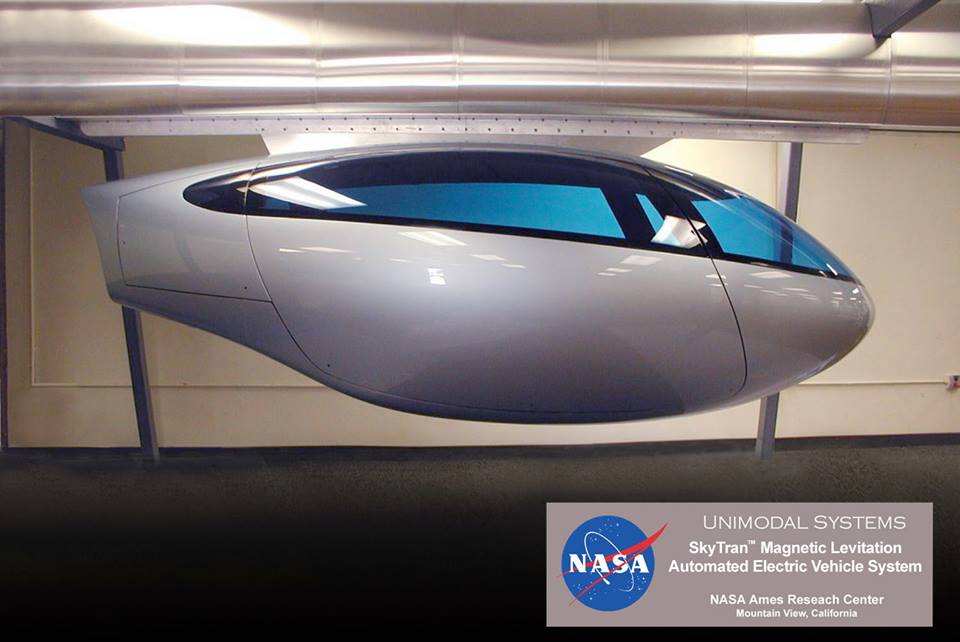Traffic congestion is an old but prevalent problem in India. Last year, 1.88 million passenger cars were sold in the country. In March 2013, the total number of registered vehicles reached 172 million. This traffic congestion is faced by Indians on a daily basis.
To eliminate these major traffic woes not only India but other countries too, skyTran, a Personal Rapid Transit system is already being developed by Unimodal Inc. and NASA. According to the report, this transit system would combine magnetic levitation with computer-controlled cars flying along rails suspended above-ground. The low-cost network would give passengers the liberty to reach their destinations without facing any traffic jams or halting at intermediate stations. This will be similar to the transit system shown in the animated, comic science fiction show ‘The Jetsons’!
 (Image Credits: Image by skyTran)
(Image Credits: Image by skyTran)
Through his personal experience of facing traffic congestion in India, Jerry Sanders, the CEO of skyTran, stated that ’60 minutes’ drive could easily convert to ‘4 minutes’ drive by this futuristic transit system. Focusing more on India, the skyTran CEO brought to light that this Asian country is already ‘paying a very high price for congested traffic’ i.e. pollution health, stress, time lost and GDP.
skyTran can eliminate India’s major traffic woes to a great extent. Here are some key highlights of the system:
- Firstly, the beauty of this system lies in the fact that it does not require much physical space for establishing it. 18-inch wide steel poles installed at regular distances can support the skyTran system. India, as a country, has a high density of population. With 1.3 billion people and nearly-unplanned urbanization, availability of physical space is a concern. skyTran system can easily be set up even after taking into account the lack of physical space in India.
- Secondly, since it’s an aviation vehicle, there is no need for constructing stations as it can easily go in and out of the buildings. This will cut-down major expenses that is usually incurred in erecting such public structures by the authorities.
- Thirdly, unlike trains, the passengers can leave for their destinations whenever they wish to. There are no fixed schedules to follow. Passengers will have the freedom of travelling to any place just like private cars.
- Fourthly, to ensure safety of the passengers, skyTran is being designed in such a manner that it does not ‘fall out of the sky’ and has high crashworthiness. These features will give a sense of relief to the passengers as they fly to their destinations.
- Fifthly, skyTran has an identity-recognition feature in it. This secures the vehicle from any theft related concerns. The passengers will have to register themselves to gain access to the vehicle. In 2013, 1.65 lakh vehicles were stolen in India. Identity-recognition feature by skyTran is a must!
- Sixthly, to prevent air-crashes, all these vehicles will fly in the same direction and at the same speed. This will again ensure the safety of passengers to the utmost extent.
- Lastly, it will be highly advantageous for taxi drivers. Since there will be no traffic jams because of this aviation vehicle, the taxi drivers will not end up losing money because of the same.
Recognizing its importance and relevance, the Indian Government has mostly given the nod to this development. By the end of this year, relevant details will be submitted to the Indian Government by the developers. A similar project in Kerala is already awaiting government’s approval. Delhi and Mumbai might witness similar developments too.
The pilot version of it is present in NASA. The prototypes are already being developed in Tel Aviv, Charles De Gaulle Airport, Atlanta Airport and Baltimore.
To check out more details of this project, please watch the SkyTran NASA talk below by Jerry Sanders, the CEO of skyTran, that took place in the city of Mumbai, India:
Google’s Chairman – Eric Schmidt – has recently backed this inventive project through an undisclosed investment. The developers hope that within 5 years, skyTran will have a momentous foothold at a global level, especially in India and other Asiatic countries. Ankur Bhatnagar, the Indian co-founder of skyTran and an IIT alumnus, is giving a major push to this project in the Indian subcontinent. Jerry Sanders states that Ankur Bhatnagar is their ‘eyes and ears’ for understanding the Indian market and possible developments that can take place in the years to come.
What is your opinion about the futuristic skyTran vehicle? When developed and launched, would you be excited to ‘fly’ in it?



















